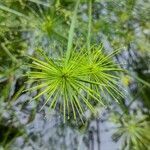Herbs, perennial, cespitose, shortly rhizomatous. Culms trigonous, (2–)25–60(–100) cm × 1–4 mm, soft (flattened in drying), glabrous. Leaves usually reduced to sheaths, occasionally with blades, flat to V-shaped, (3–)10–30 cm × (1–)2.5–5 mm. Inflorescences: heads loosely digitate; rays (5–)10–12(–15), 1–15(–20) cm; 2d order rays usually present, (1–)6–12(–25) mm; 3d order rays sometimes present, 1–6 mm; bracts 2(–3), horizontal to ascending at 30–60°, longer (3–)6–18 cm × 2–4 mm, shorter (0.5–)2.5–6.5 cm × 1–2(–3) mm. Spikelets 1–15, linear-lanceoloid, ± compressed-quadrangular, 3–18 × 1–1.6 mm; floral scales 10–20(–40), laterally reddish to greenish brown, dull, often clear-edged, medially greenish, laterally 1-ribbed, medially 1-ribbed, oblong to obovate, 1–1.5(–1.9) × 0.8–1 mm, apex mucronate, glabrous except for cluster of crystalline prickles at apex. Flowers: stamens 3; anthers 0.3–0.5 mm; styles 0.4–0.9 mm; stigmas 0.5–0.8(–1.3) mm. Achenes white or reddish brown, stipitate, globose to obovoid or ellipsoid, 0.5–0.6(–0.7) × 0.3–0.4(–0.5) mm, base nearly cuneate, stipe 0.1 × 0.1–0.2 mm, apex obtuse to acute, apiculate or entire, surfaces granular to papillose.
Somewhat cespitose perennial 2–7 dm; lowest cauline lvs ordinarily reduced to blade less sheaths, the uppermost either bladeless or rarely with well developed blade; bracts 2, erect or ascending, usually shorter than the infl; rays none or to 10 cm, often branched at the top; spikes short, loosely subglobose, 1–2 cm thick; spikelets to 1 cm, flattened with 5–25 fls; rachilla persistent; scales ovate or elliptic, 1–1.5 mm, 3-nerved in the center, obtuse, often red-purple; rachilla wingless; achenes obovoid-trigonous, pearly white, 0.4–0.7 mm; 2n=26. Swamps and shallow water, mostly near the coast; pantrop., n. to se. Va.
Perennial from short slender rhizomes, or sometimes annual; culms weak; leaves mostly short and reduced to sheaths; bracts commonly 2 and shorter than the inflorescence, sometimes elongate; inflorescence usually compound, the spike-lets numerous, 5-15 mm. long, 10-to 30-flowered, compressed, reddish-or greenish-brown; scales 1.5 mm. long, obtuse, minutely apiculate; achene minute (0.6 mm. long), obovoid, trigonous, yellow (frequently becoming whitened), with rough granular surface.
A herb. It is a soft sedge. It grows 15-60 cm high. The stems forms tufts or can creep short distances. The leaves are reduced to scales which sheath the stem. The culms are 15-60 cm high. They can be flat or 3 angled. The bracts are 5-7.5 vm long. The spikelets are small and shiny brown.
A spreading inflorescence with near linear spikelets in groups of 1–3
Two unequal bracts
Weak angular stems
Tufted perennial
Purple sheaths



